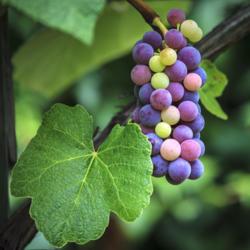
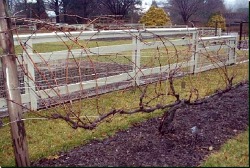
Grapes are best trellised on a wire system. Growing on a fence allows you to grow grapes in a small space.
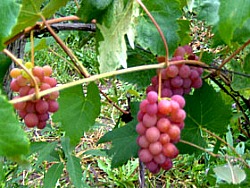
Grapes produce clusters of fruits off the one-year old canes.
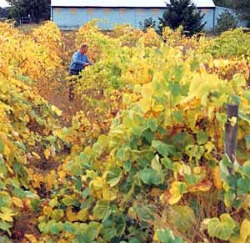
Grapes are vigorous plants and need to be pruned back severely, removing more than 70 per cent of the canes in winter to get the best production.
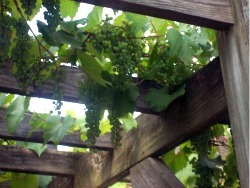
Grow grapes on an arbor to provide shade, atmosphere, and food for your family.
Grape growing is booming across the country. As more people try to grow their own edible landscapes, they are realizing that grapes fit into the picture perfectly. Grapes produce fruit a few years after planting, the vines are vigorous but can be pruned to fit in small spaces, there are varieties adapted to almost any climate in the country, and the plants are long lived, yielding grapes for eating, juicing and wine making for years.
However, there are some gardeners who still shy away from grapes because of the pruning they need. Pruning grapes can seem daunting and a mystery to the inexperienced gardener. However, with a little understanding and trial and error, you can learn to how to prune your vines to keeping them under control and producing well.
How to prune your grapes depends on how you're growing them. If you're growing table or wine grapes for maximum production, training them on a fence is the way to go. For small spaces consider growing grape vines on individual stakes. For atmosphere, shade, and as a landscape feature, try growing grapes on an arbor. No matter how you grow them, grapes should be in your yard. Don't let the need for pruning stop you from giving them a try.
Grape Vine BasicsThe key to pruning grapes is understanding their fruiting habit. Grapes produce the most fruit on shoots growing off of one-year-old canes. If you have too many old canes (from no pruning), then you'll get fewer grapes. If you prune back your vines completely each year, then you get lots of new growth, but again, few grapes.
For the first year or so, pruning is basically the same for each of these three methods. The goal is to create a strong root system and trunk. Plant in spring and prune back the grape vine to three buds. Place the vine near a stake and attach it to keep the vine growing vertically. As it grows, select the strongest shoot and let it grow. From here on the pruning systems vary.
Grapes on a FenceOnce you've selected a main cane, allow two canes to form on either side of the main trunk at about the height of your first horizontal wire (about 3 feet). Let the trunk grow up further and top it once it reaches the ultimate height (usually 5-6 feet). Allow two more canes to develop on either side of the main trunk.
The first winter, prune back the side canes to 3 buds on each and construct wire supports for them to be attached to. As the side canes grow, attach them to the wire and remove all other canes coming off the side canes or trunk. Remove fruit clusters because you want the vines to send energy into growing strong roots and a trunk at this point.
The second winter, prune back the side canes so they have about 10 buds on each. The next year they will grow shoots that will fruit. Select four other shoots close to the side canes and prune these back to two buds on each. These will be renewal spurs for the following year's production.
The third winter prune back the side canes that fruited to the trunk and prune back the renewal spurs to ten buds and select four more renewal spurs for the following year's fruit. Continue this process each winter. You should be removing up to 70% of the grape canes each winter.
Grapes on a StakeIf you are low on free space, try growing grapes on a stake. Pound in a sturdy stake next to the grape vine and securely attach it. Let the vine grow to the top of the stake the first year then top it. Allow 4 to 5 side canes to grow. Remove all the rest.
The first winter, cut back the side canes to three buds on each. These will send out shoots that will produce grapes the next year. Remove all weak and spindly growth, especially along the lower parts of the trunk. The second winter, prune back the healthiest canes to six to ten buds, select two canes as renewal spurs and prune those back to three buds on each and remove all other canes. Repeat this pruning each winter. Your trunk should be able to support four to seven fruiting canes each year as it gets older.
Grapes on an ArborIf you like the thought of eating grapes hanging down from an arbor in the shade during a hot summer day, well here's how.
Make sure you have constructed a sturdy arbor to hold the weight of the grape vines. It may be a two, four or six post arbor, depending on whether it's attached to the house or another structure. The top can be secured with 2-inch by 4-inch wooden slats that hold the arbor together and topped with 1-inch by 2-inch wood pieces to create the lattice work for the vines to grow on. You may also need corner braces to secure the whole structure.
Grow the grapes, one per post, selecting the strongest cane. Allow it to grow to the top of the post the first year, securing it to the post as it grows. The first winter top the cane and allow it to grow side branches along the top of the arbor. If you let the vines just continue to grow, they will produce dense shade, but little fruit. Prune the grapes each winter by removing those canes that fruited the previous year, cutting back one-year-old canes to five to six buds, and leaving some renewal canes pruned back to two to three buds. The goal is to have canes on the trellis spaced 2 to 3 feet apart. Remove any weak, thin canes. You want to leave enough fruiting canes on the trellis to fill it back in each summer, but not so many that is becomes a tangled mess.
More articles on pruning grape vines:Grape Pruning: Three Systems
Grape Arbors Simplified
Of Muscadines and Scuppernongs
Grape Training Systems
 Charlie Nardozzi is an award winning, nationally recognized garden writer, speaker, radio, and television personality. He has worked for more than 30 years bringing expert gardening information to home gardeners through radio, television, talks, tours, on-line, and the printed page. Charlie delights in making gardening information simple, easy, fun and accessible to everyone. He's the author of 6 books, has three radio shows in New England and a TV show. He leads Garden Tours around the world and consults with organizations and companies about gardening programs. See more about him at Gardening With Charlie.
Charlie Nardozzi is an award winning, nationally recognized garden writer, speaker, radio, and television personality. He has worked for more than 30 years bringing expert gardening information to home gardeners through radio, television, talks, tours, on-line, and the printed page. Charlie delights in making gardening information simple, easy, fun and accessible to everyone. He's the author of 6 books, has three radio shows in New England and a TV show. He leads Garden Tours around the world and consults with organizations and companies about gardening programs. See more about him at Gardening With Charlie.
 Victory Seed Company has all the seeds you want for your best garden in 2024.
Victory Seed Company has all the seeds you want for your best garden in 2024.
For 25 years, the family-owned Victory Seed Company has provided the highest quality vegetable, herb and flower seeds to families across the country. We are passionate about providing you the best seeds available that give excellent germination, robust plants, and the harvest you want. With a catalog of over a thousand varieties, we have everything, and our prices are the kinds that we'd want to pay. We have hundreds of yesterday's heirloom vegetables, as well as today's award winning hybrid selections. Get to know us by visiting our website and browsing through our online vegetable seed catalog.